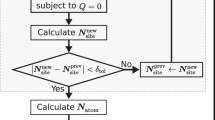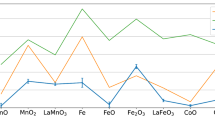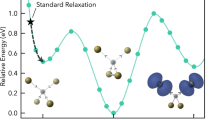Abstract
THE part played by true point defects—isolated vacancies and interstitial atoms—in defect solid solutions and in mixed valence non-stoichiometric phases is not clear. In many ionic or quasi-ionic structures there is some structural reorganization and at least incipient ordering of defect clusters. In some oxides—notably those of titanium, vanadium, molybdenum and tungsten, in which the covalent component of the bonding is probably strong—slight reduction, with a change in the ratio of oxygen to metal, is accommodated largely by crystallographic shear. A complete sheet of anion sites is eliminated from the structure, forming an extended defect and greatly diminishing the extent to which a deficit of oxygen must be compensated by anion vacancies or interstitial cations. Thus Hyde and Bursill1 found that, in slightly reduced rutile, TiO1.9986, the point defect concentration could hardly exceed 10−4. In more extensively reduced rutile, changes in stoichiometry involve only changes in the spacing between crystallographic shear planes, without detectable concentrations of localized defects.
This is a preview of subscription content, access via your institution
Access options
Subscribe to this journal
Receive 51 print issues and online access
$199.00 per year
only $3.90 per issue
Buy this article
- Purchase on Springer Link
- Instant access to full article PDF
Prices may be subject to local taxes which are calculated during checkout
Similar content being viewed by others
References
Bursill, L. A., and Hyde, B. G., Phil. Mag., 23, 3 (1971).
Wadsley, A. D., and Andersson, S., Perspectives in Structural Chemistry (edit. by Dunitz, J. D., and Ibers, J. A.), 3, 1 (Wiley, New York, 1970).
Allpress, J. G., Sanders, J. V., and Wadsley, A. D., Acta Cryst., B 25, 1156 (1969)
Allpress, J. G., and Wadsley, A. D., J. Solid State Chem., 1, 28 (1969).
Allpress, J. G., J. Solid State Chem., 1, 66 (1969).
Allpress, J. G., J. Solid State Chem., 2, 78 (1970).
Anderson, J. S., Browne, J. M., and Hutchison, J. L., J. Solid State Chem., 5, 419 (1972).
Gruehn, R., Nat. Bur. Stand. Spec. Pub., 364, Solid State Chemistry (National Bureau of Standards, 1972).
Allpress, J. G., and Roth, R. S., J. Solid State Chem., 3, 209 (1971).
Levin, E. M., J. Res. Nat. Bur. Stand., 70 A, 5 (1966)
Browne, J. M., Hutchison, J. L., and Anderson, J. S., Proc. 7th Intern. Symp. on the Reactivity of Solids, 116 (Chapman and Hall, London, 1972).
Roth, R. S., Wadsley, A. D., and Andersson, S., Acta Cryst., 18, 643 (1965).
Schäfer, H., Angew. Chem. Internat. Edn., 5, 40 (1966).
Levin, E. M., and Roth, R. S., J. Solid State Chem., 2, 250 (1970).
Author information
Authors and Affiliations
Rights and permissions
About this article
Cite this article
ANDERSON, J., BROWNE, J., CHEETHAM, A. et al. Point Defects and Extended Defects in Niobium Oxides. Nature 243, 81–83 (1973). https://doi.org/10.1038/243081a0
Received:
Issue Date:
DOI: https://doi.org/10.1038/243081a0
This article is cited by
-
Exploiting dimensionality and defect mitigation to create tunable microwave dielectrics
Nature (2013)
-
Spectrophotometry of AR Lacertae
Astrophysics and Space Science (1990)
-
Photoelectric elements of AR Lacertae
Astrophysics and Space Science (1981)
Comments
By submitting a comment you agree to abide by our Terms and Community Guidelines. If you find something abusive or that does not comply with our terms or guidelines please flag it as inappropriate.



